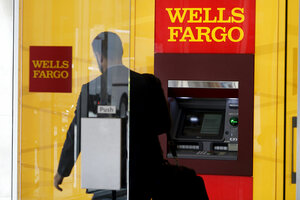Americans pay more than $11 billion in overdraft fees: Report
A report released on Tuesday by the Pew Charitable Trusts finds that banks charge $30 dollars or more for each overdraft, often far more than the amount consumers overdraw by.

A man walks by a bank machine at the Wells Fargo & Co. bank in downtown Denver.
Rick Wilking/Reuters/File
Banks both large and small engage in practices that disadvantage their most financially precarious customers, as overdraft fees continue to rise.
A new report by the Pew Charitable Trusts finds that overdraft fees have risen dramatically over the last several decades, even at small banks, a practice that critics say harms those who are most vulnerable.
“Working families need banks that don’t exploit them,” says Lauren Saunders, the associate director of the National Consumer Law Center in a phone interview with The Christian Science Monitor. “Overdraft fees will keep going up until regulators do something to stop this.”
According to a Pew Charitable Trusts report released on Tuesday, the median overdraft fee charged by small banks is $32 dollars, often far more than the amount by which consumers overdraw their accounts. Large banks typically charge about $35 dollars for an overdraft, with overdrafts netting all US banks a total of more than $11 billion per year.
Tuesday’s report assessed 45 small banks in 36 states, each holding less than $1 billion in assets, and found that all 45 banks allowed bank account holders to pay up to $90 per day for overdraft servicing, if not more.
Overdraft fees have become an increasingly common (and lucrative) practice among banks as interest rates have fallen in recent years. In fact, overdraft fees have doubled over the past 30 years, Pew reports.
“Banks are trying to find new ways to generate revenue with interest rates so low,” says J. Michael Collins, faculty director of the Center for Financial Security at the University of Wisconsin-Madison, in a phone interview with the Monitor.
For their part, banks say that consumers can choose to avoid overdraft fees, and must decide "opt in" to "overdraft protection, as the federal government requires banks to have their default practice be declining a charge instead of charging an overdraft to cover it. But in practice, most consumers have no idea what is on the various forms they sign when they open an account, and do not realize that they have "opted in," say Pew researchers.
In addition, says American Bankers Association spokesman Mike Townsend, consumers can always choose to keep a minimum balance in their accounts to avoid an overdraft and can choose to not spend more money than they have.
But as Dr. Collins noted, the choice is not that easy. Sometimes it isn’t much of a choice at all.
“Sometimes it is a calculated decision. Some people might overdraft on purpose if it is a question of overdrafting or not paying a bill for the month,” Collins tells the Monitor in a phone interview. “They decide that it would be worse to not pay a bill than to take an overdraft fee.”
And sometimes, Pew Charitable Trusts Consumer Banking Project research officer Joy Hackenbracht tells the Monitor, consumers don’t even know that overdraft fees are there, or when they will kick in.
Banks have tools to help, writes Virginia O’Neill, senior vice president of the American Bankers Association’s Center for Regulatory Compliance, in an email to the Monitor. “Banks offer consumers multiple tools to manage their accounts and avoid overdrawing, including text alerts about low balances and the ability to monitor their accounts online or by phone at all times."
Pew researchers found that more than 40 percent of American banks rearrange the order of withdrawals during processing each night, paying the biggest items first, instead of the order in which they are charged. That practice overdraws the account more quickly, increasing the number of overdraft fees that may be assessed each day.
Consumer advocacy groups are now speaking out against this "reordering" practice, which they call unfair and exploitative.
Pew's Dr. Hackenbracht tells the Monitor that the Federal Deposit Insurance Corporation (FDIC) has issued guidelines that advise banks to limit overdraft charges to six times each year, while the Consumer Protection Bureau anticipates drafting policies in early 2017.
“The prevalence of fee-based overdraft programs at both large and small banks underscores the need for new policies to prevent ‘courtesy’ overdraft programs from being costly and unsustainable forms of short-term credit for many financially vulnerable consumers,” said Nick Bourke, director of Pew’s consumer finance project, in a Pew press release. “Regulators should set reasonable limits on overdraft fees and help banks create new small-credit options for those who want them.”
One best practice that Pew recommends is for banks not to allow account holders to "opt in" to overdrafting. Pew reports that approximately two-thirds of bank account holders would rather have their cards declined altogether than pay an overdraft fee.

